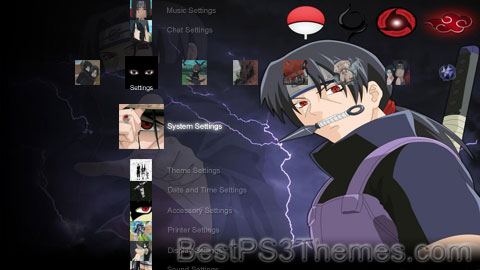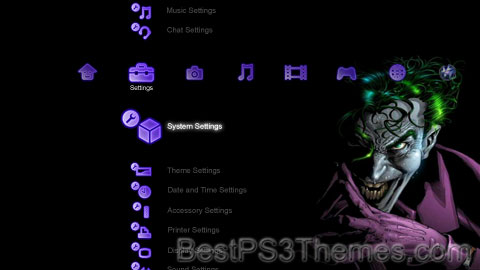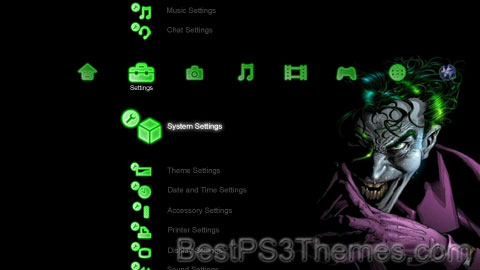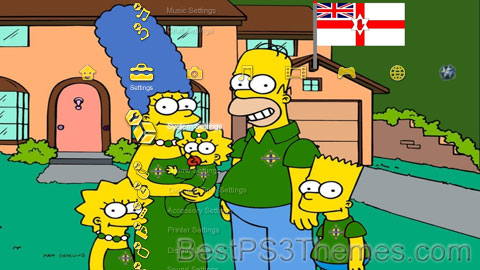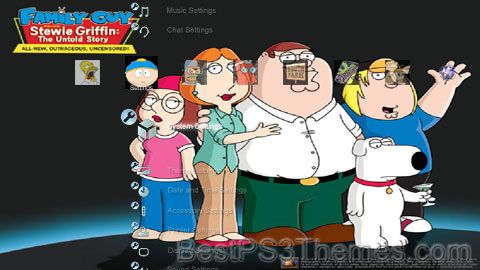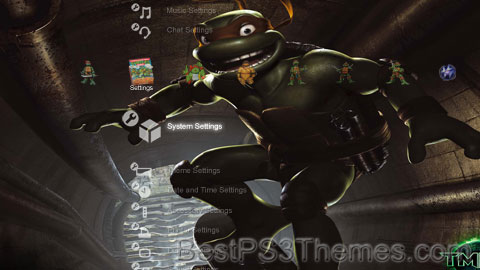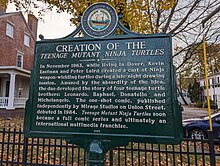Invader Zim theme by Jeff Leezer (punchjeff)
Download: InvaderZim.p3t
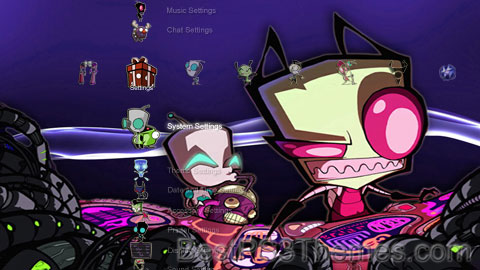
(5 backgrounds)
This article contains wording that promotes the subject through exaggeration of unnoteworthy facts. (January 2024) |
| Invader Zim | |
|---|---|
 | |
| Genre | |
| Created by | Jhonen Vasquez |
| Directed by |
|
| Voices of | |
| Theme music composer | Kevin Manthei Mark Tortorici |
| Composers |
|
| Country of origin | United States South Korea |
| Original language | English |
| No. of seasons | 2 |
| No. of episodes | 27 (46 segments) (+1 pilot) (list of episodes) |
| Production | |
| Executive producers |
|
| Producers |
|
| Animator | Sunwoo Entertainment |
| Running time | 24 minutes |
| Production companies |
|
| Original release | |
| Network | Nickelodeon |
| Release | March 30, 2001[11] – December 10, 2002 |
| Network | Nicktoons |
| Release | June 10 – August 19, 2006 |
| Related | |
| Invader Zim (comics) Invader Zim: Enter the Florpus | |
Invader Zim is an American animated science fiction dark comedy television series created by comic book writer and cartoonist Jhonen Vasquez for Nickelodeon. The series centers on an extraterrestrial named Zim (voiced by Richard Steven Horvitz), from the planet Irk, and his mission is to conquer Earth and enslave the human race along with his malfunctioning robot servant GIR (Rosearik Rikki Simons). He is antagonized by Dib (Andy Berman), a young paranormal investigator who is determined to stop Zim from succeeding.
Nickelodeon contacted Jhonen Vasquez about pitching ideas for an animated series for their older demographic[12][13][14] and Invader Zim was the first thing he pitched. In Vasquez's words "it went from pitch to series without hardly any waiting".[15] As the series went on, ratings declined and budgetary issues became more frequent.[16] Before the second season was completed, Nickelodeon cancelled the series, leaving several episodes unfinished.[17] The show originally aired on Nickelodeon from 2001 to 2002,[16][11] with six of the completed second-season episodes initially going unreleased. These episodes were first made available on DVD in 2004 and later made their television debut on the Nicktoons Network in 2006.[16][18]
Invader Zim received positive reviews from critics and audiences,[16] with praise primarily directed at its humor, writing, animation, art-style, and the way it pushed the boundaries of what was considered acceptable on children's television. In the years following its cancellation, Invader Zim has often been listed as one of Nickelodeon's best shows.[19][20][21][22][23] The series won an Annie Award, an Emmy Award and a World Animation Celebration Award, and received nominations for seven additional Annie Awards and two Golden Reel Awards. Invader Zim has spawned its own fan convention called InvaderCON and a plethora of official merchandise,[16] including video games, toys, clothing and accessories, among many other products. Despite its early cancellation and short run, due to increasing popularity and above-average merchandise sales[9][24][25] it has been widely regarded as a cult classic.[9][25][26][27][28][29]
A monthly comic book series of the same name was released on July 8, 2015, as a continuation of the television series and published by Oni Press until August 4, 2021.[30][31] A film based on the television and comic series[32][33] titled Invader Zim: Enter the Florpus, premiered on Netflix on August 16, 2019, marking Invader Zim's first new animated production since its Nickelodeon airing.[34]
Plot[edit]
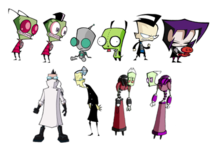
Bottom: Professor Membrane, Ms. Bitters, Almighty Tallest Red, and Almighty Tallest Purple.
The series centers on Zim (voiced by Richard Steven Horvitz),[35] a member of the extraterrestrial Irken species and the Irken Empire from the planet Irk. The empire's goal is universal conquest and has a social hierarchy based solely on physical height. The empire's leader is called The Almighty Tallest; at the beginning of the series the position is jointly held by two equally tall individuals (Wally Wingert and Kevin McDonald). Zim is an outcast; he is delusional, very short, overzealous, narcissistic, and megalomaniacal.
An absentminded Zim nearly destroyed Irk and the Irkens during the empire's first invasion, Operation Impending Doom I. He was punished by exile to the Irken food court planet Foodcourtia, although he failed to recognize the reason for his banishment. After learning that Operation Impending Doom II was being planned, Zim unilaterally "quits being banished" to attend the Great Assigning on the convention center planet Conventia. At the Great Assigning, The Tallest appoints Irkens as Invaders, advance scouts tasked with infiltrating and preparing target planets for conquest by the Irken Armada. Zim successfully pleads to be made an Invader, and receives a "secret mission" intended to prevent interference with the invasion; the target "mystery planet" is on the outskirts of the known universe and is not confirmed to exist. He is issued GIR (Rosearik Rikki Simons), an ineffective and erratic Standard Issue Information Retrieval (SIR) unit hastily made from spare parts found in a trash can.
After a six-month journey across the universe, Zim arrives at the "mystery planet" which turns out to be a dark, dystopian, and satirical version of Earth centuries into the future, with rampant mindless consumerism, although it appears that humans have abolished all wars. A delighted Zim quickly goes to work and sets up his base in a random suburb; The Tallest are dismayed by his success. A short-statured Zim disguises himself as a human child with a green complexion (which he claims is caused by a "skin condition"). The show follows his attempts to conduct espionage by attending a local school (spelled "Skool") and planning to conquer and enslave the world at his base. Opposing Zim is his classmate Dib (Andy Berman), a paranoid young boy who is obsessed with the paranormal and supernatural and the only human (besides his sister) who sees through Zim's disguise. Dib is determined to expose and thwart Zim, despite the hostility and mockery he receives from his oblivious peers for doing so.
Supporting characters include Dib's cynical and apathetic sister Gaz (Melissa Fahn); Zim and Dib's demonic teacher Ms. Bitters (Lucille Bliss); and Dib and Gaz's famous, but neglectful father Professor Membrane (Rodger Bumpass). Later in the series, other alien characters begin to appear, including Tak (Olivia d'Abo), a fellow Irken seeking revenge against Zim; Lard Nar (Fred Tatasciore), the leader of a resistance group called The Resisty who wants to overthrow the Irken Empire; and Sizz-Lorr (Jim Wise), Zim's former employer from Foodcourtia who attempts to recapture him.
Episodes[edit]
| Season | Episodes | Segments | Originally aired | |||
|---|---|---|---|---|---|---|
| First aired | Last aired | Network | ||||
| Pilot | May 11, 2004 (DVD) December 24, 2011 (TV) | Nicktoons | ||||
| 1 | 20 | 36 | March 30, 2001 | July 12, 2002 | Nickelodeon | |
| 2 | 7 | 1 | 1 | December 10, 2002[n 1] | Nickelodeon[n 1] | |
| 6 | 9 | June 10, 2006 | August 19, 2006 | Nicktoons | ||
| Enter the Florpus | August 16, 2019 | Netflix | ||||
Production[edit]
Conception and early development[edit]
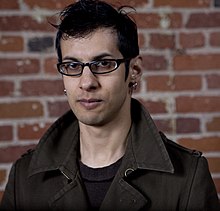
There was no way I was gonna say 'no'. The fact that they took a chance on someone a lot of people wouldn't have given a kids show to is one of the coolest things that ever happened to me in my life. — Jhonen Vasquez[15]
Prior to the creation of Invader Zim, Nickelodeon desired a series to suit its 11–15 year old demographic.[36][37] Nickelodeon producer Mary Harrington was searching for something that had a similar "edge" to The Ren & Stimpy Show, when she came across a comic book called Johnny the Homicidal Maniac and was impressed with the art-style and character designs in the series. Harrington contacted the creator of JtHM, then-22-year-old Jhonen Vasquez, who had zero experience in animation at the time, and asked him if he would like to pitch an animated series to Nickelodeon. Vasquez accepted the offer.[38][39][40]
Vasquez knew from the start that his previous works were definitely not suitable for Nickelodeon, so instead of adapting something he had already done, he decided to make something new. Since he was creating a show for a children's network, Vasquez compiled together many things he loved during his own childhood, including robots, monsters, horror films, science fiction films, paranormal investigators, Monty Python, the works of Douglas Adams, and aliens.[39] Before settling on the darker concept of an alien invader, Vasquez briefly considered doing a more light-hearted show along the lines of Mork & Mindy, with a zany alien misunderstanding Earth customs and ultimately, learning a lesson at the end. Vasquez said that while this idea probably would have found more success on Nickelodeon, he quickly dropped the idea, believing it would not fit his style of writing.[40] Vasquez came up with the entire premise for Invader Zim in about an hour, while sitting in bed when he could not sleep. He was inspired by the idea of an alien who came from an incredibly advanced race and has access to such powerful and advanced technology that he could easily take over or destroy the Earth single-handedly, but instead he decides to stay in school all day, never even thinking to sneak out.[41]
A pilot for Invader Zim was pitched to Nickelodeon in 1999,[40][42] which led to the series being green-lit. Vasquez indicated that very little of his writing style was changed over the course of Invader Zim, other than restricting certain language and visuals that may not be suitable for children. Vasquez cited that the biggest change for himself was going from working alone on a comic to working with thousands of people at Nickelodeon, saying "it's an absolute misery".[4] However, he said the experience of working on Invader Zim was "incredibly gratifying", but also "fiendishly frustrating".[4][43]
Animation[edit]
Invader Zim was produced by Nickelodeon Animation Studios in Burbank, California with Nick Digital providing the CGI animation services and Sunwoo Entertainment in South Korea providing the 2D animation services. Salami Studios provided the post-production and sound services for most episodes of the series, and Encore and Hollywood Digital provided the post-production services for a few episodes in season one. In season two, the animation style became slightly more stylized and pronounced in motion than in season one.[44] Invader Zim's art style is stylized with sharp edges, thick black outlines, big heads, small or elongated bodies, and big eyes for the characters. Invader Zim's art-style was initially difficult for the animators to learn. Director Steve Ressel even admitted that it was the hardest style he had ever worked on, citing the characters' heads as the most complicated aspect of their designs.[43]
Invader Zim was one of the first animated television shows to merge 2D animation with CGI animation.[43] When the development on Invader Zim was first getting started, Steve Ressel consulted with the crew of Futurama to figure out how to integrate 2D animation with CGI animation, since they were one of the first animated television shows that merged the two mediums. When the Futurama crew saw the show they were very impressed by how seamlessly the Invader Zim crew integrated both mediums, specifically in the episode "The Wettening".[43]
While the average episode of an eleven-minute animated television show usually has around 80–120 pages of storyboards per episode, Invader Zim's storyboards were around 250–350 pages per episode. This is because Invader Zim has a very dedicated attention to detail outlining every ounce of a character's movements and method of acting, which is something Nickelodeon was very impressed by.[43]
The episode "Zim Eats Waffles" was originally supposed to be one long shot, panning between Dib's reaction and his computer screen. This was because the animators wanted to try to have the longest single shot in animation history. However, this idea was scrapped, due to it limiting the episode's storytelling capabilities and it being too difficult to animate. Despite this decision, the majority of "Zim Eats Waffles" still ended up being one continual scene.[43]
Voice acting[edit]
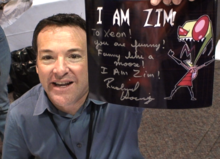
When casting voice actors for Invader Zim, Vasquez did not want actors who were just capable of doing zany voices because it sounded less natural to him. He made a point to cast people with speaking voices that were naturally distinct and out of the ordinary so that the cast did not have to do unnatural voices, but could instead just speak naturally.[43][45]
Mark Hamill was originally hired to do the voice of Zim for the pilot episode, but was replaced before the pilot was shown to Nickelodeon executives because Vasquez felt his voice did not feel right for the character.[43] Hamill was replaced by voice acting professional Billy West, who remained the voice of Zim for the pilot. After the show was picked up for a full series, Vasquez decided to replace West with Richard Steven Horvitz (who was already voicing the character of Daggett on fellow Nickelodeon series, The Angry Beavers), saying that West was "too well known" and that he wanted all of the voices for the main characters to be unique and not voices people had heard before. Also, due to Futurama still being on the air at the time, Vasquez did not want the same voice actor to be the lead in two contemporaneous sci-fi comedies.[46]
Vasquez wanted someone with no experience in voice acting to play the part of GIR, as a reflection of how broken and messed up GIR really is.[43] Vasquez wanted someone who sounded unprofessional, but all of the actors who auditioned for GIR were "good actors" who just did a "stock crazy robot voice", which he found dissatisfying. Vasquez then asked his friend, Rosearik Rikki Simons, who was working with him on his comic called I Feel Sick at the time, to try to audition for GIR, saying he "couldn't screw it up anymore than anyone else".[47] Simons did a few different voices for his audition for GIR, including one where he was trying to imitate his mother-in-law, but decided it was too "shrieky". He then remembered when he used to play with hand puppets with his father as a kid and tried to do one of those voices. Simons was also a colorist on Invader Zim and in November 1998, the same month he auditioned for GIR, he also helped color the pilot episode.[43] Vasquez said he gave Simons the part of GIR because he was "bad at it", and that fit the character.[48] When voicing GIR, Simons' voice was edited to make it sound higher-pitched and metallic. While Simons eventually learned to perform the voice without the high-pitch editing, the metallic quality still had to be added. Unedited versions of Simons' voice-overs can be heard in voice recordings for the unfinished episodes.[46]
Music[edit]
Kevin's music wasn't just an addition to the show, it was crucial for the show to be what it was. Without his intense sounds lending a sense of urgency and seriousness to the ridiculous proceedings within Zim, I could never have given the good little children of the Earth as many nightmares as I did. — Jhonen Vasquez[49]
Vasquez asked his friend Mark Tortorici to come up with the theme music for Invader Zim. Vasquez said all he really wanted for the theme music was military music to represent Zim mixed with futuristic electric orchestral music. Once the direction for the music was settled on, Tortorici produced the theme music on an Alesis QS8 very quickly and it did not go through many changes, but they did reorchestrate it for the TV series and stuck with it from that point on.[50][51]
Vasquez's team selected Michael Tavera, who is known for composing the music for The Land Before Time, An American Tail, and Stitch! The Movie, to compose the music for the pilot episode of Invader Zim. Vasquez said that he asked for several of the tracks that Tavera produced to be discarded and that ultimately the team had less than half of the number of tracks that they planned to submit.[51] According to Vasquez, he and Tavera were not "a great fit" for one another creatively. Vasquez described the pilot music as having a "more 'children's television' sound," with a "much more traditional and not as surprising" theme as he wanted, but added that the music "worked for the pilot."[51] Tavera's cover version of Tortorici's theme music did not appear in the pilot as there was no opening credits sequence.[51] Vasquez said that members of the Invader Zim crew laughed at Tavera's version of the theme because it was "cheesy," adding that the reaction was not mean-spirited and that Tavera had received little information about the series before submitting the music.[46][51]
Tavera did not become a part of the regular Invader Zim crew, and was replaced with Kevin Manthei, who is also known for composing the music for Generator Rex, The Sims 2 (PSP), and Robot Chicken, to compose the series' music.[51] Manthei's music for the series is industrial and techno in nature.
The anime internet radio station "Anime Stuff R" produced a radio broadcast special titled "The Kevin Manthei Invader Zim-phony Special" which featured a majority of the music Kevin Manthei composed for Invader Zim. The broadcast special was hosted by Kevin Manthei, DJ Richard Rae and Tom Mitchell (DJ Tomzer1) and was broadcast from September 13, 2002, to October 15, 2002. The entire broadcast is 5 hours, 26 minutes, and 28 seconds long and includes music from every episode of Invader Zim, except for "The Most Horrible X-mas Ever". The broadcast was extremely popular, so Anime Stuff R (temporarily renamed "Anime Stuff Z" for the special) decided to release a CD of the broadcast. However, due to financial reasons, they only made 100 copies of this CD. There are 325 tracks on the CD and the interior of the CD cover features messages from both Kevin Manthei and Richard Rae.[52][46]
Kevin Manthei's message says:
When I was approached by Richard E. Rae about the possibility of an internet radio show featuring hours and hours of my "Invader Zim" music, I was thrilled. What a great opportunity to let the fans of "Invader Zim" hear the music!
Richard went way beyond what I thought the show was going to be, and he poured his heart and soul into producing the "Zim-phony". Richard is not just a fan, he's a professional who uses his passion for music and his willingness to work hard at it to produce great shows. I am honored that he and Tom took the time to put the "Zim-phony" and this "Special Edition" together.
Happy listening!
Richard Rae's message says:
We took chances with the "Zim-phony Special".
I took a chance by approaching Kevin Manthei with the idea. Kevin took a chance in trusting his music to someone he only knew from e-mail. My friend Tom took a chance too, okaying a show with music from an American cartoon series instead of a Japanese Anime. These chances definitely paid off! The "Zim-phony Special" broke every Anime Stuff R ratings record, thanks to the overwhelming response to this show from you, the "Invader Zim" fans. Of course, the "Zim-phony" is all about the excellent music of the remarkable Kevin Manthei. I certainly owe Kevin more thanks than I can ever hope to articulate for his terrific support during this once-in-a-lifetime experience.
This Mini CD you're holding is proof that some chances are definitely worth taking. Thank you for listening!
Challenges and censorship[edit]
Invader Zim would frequently find itself at odds with network censorship. In The Medium-Sized Book of Zim Scrips Vol. 1, series writer Eric Trueheart would characterize the relationship between the Zim staff and the executives at Nickelodeon as "a little dysfunctional", and that "the executive assigned by Nickelodeon to oversee our show - who was, and still is, a decent guy, by the way - probably felt like he had to keep a lid on an inexperienced show creator, and as a result clamped down harder than he should have."[53]: 70 Trueheart also speculated that the channel's other programming also had an effect on how the executives treated the show, stating that "Nickelodeon probably looked to Rugrats as the model of what a cartoon should be ... Invader Zim was none of these things."[53]: 77 Ultimately, "There was a just a conflict in personalities, intentions, and modus operandi ... The reality was just not a great fit, and yes, it was a problem."[53]: 71
In some episodes, it was originally intended for certain characters (such as Keef and Iggins) to be killed off at the end of an episode, but Nickelodeon would not allow any characters to be killed off and demanded the crew add certain details suggesting that they survived or in some cases, rewrite the episodes to where they would not die. They complied but did so in an intentionally forced and sarcastic way to purposely convey their disagreement and reluctance toward the decision, such as the sarcastic "No animated characters were harmed in the filming of
South Park Characters
South Park Characters theme by cymru12
Download: SouthParkCharacters.p3t
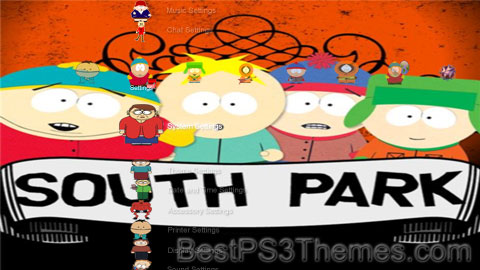
(3 backgrounds)
P3T Unpacker v0.12
Copyright (c) 2007. Anoop Menon
This program unpacks Playstation 3 Theme files (.p3t) so that you can touch-up an existing theme to your likings or use a certain wallpaper from it (as many themes have multiple). But remember, if you use content from another theme and release it, be sure to give credit!
Download for Windows: p3textractor.zip
Instructions:
Download p3textractor.zip from above. Extract the files to a folder with a program such as WinZip or WinRAR. Now there are multiple ways to extract the theme.
The first way is to simply open the p3t file with p3textractor.exe. If you don’t know how to do this, right click the p3t file and select Open With. Alternatively, open the p3t file and it will ask you to select a program to open with. Click Browse and find p3textractor.exe from where you previously extracted it to. It will open CMD and extract the theme to extracted.[filename]. After that, all you need to do for any future p3t files is open them and it will extract.
The second way is very simple. Just drag the p3t file to p3textractor.exe. It will open CMD and extract the theme to extracted.[filename].
For the third way, first put the p3t file you want to extract into the same folder as p3textractor.exe. Open CMD and browse to the folder with p3extractor.exe. Enter the following:
p3textractor filename.p3t [destination path]Replace filename with the name of the p3t file, and replace [destination path] with the name of the folder you want the files to be extracted to. A destination path is not required. By default it will extract to extracted.filename.
Kiddy Grade
Kiddy Grade theme by Wicketnezz
Download: KiddyGrade.p3t
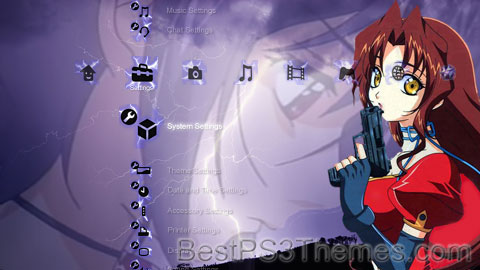
(13 backgrounds)
| Kiddy Grade | |
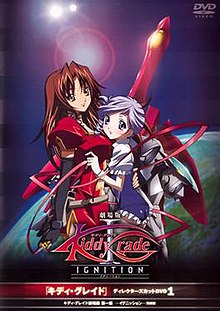 Éclair (left) and Lumière with LaMuse and Planet Aineias in the background. | |
| キディ・グレイド (Kidi Gureido) | |
|---|---|
| Genre | Science fiction |
| Created by | gímik Gonzo |
| Light novel | |
| Kiddy Grade Pr. ("Pre-story") | |
| Written by | Tomohiko Aoki |
| Illustrated by | Hidefumi Kimura |
| Published by | Kadokawa Shoten |
| Imprint | Kadokawa Sneaker Bunko |
| Demographic | Male |
| Original run | September 1, 2001 – February 1, 2002 |
| Volumes | 2 |
| Anime television series | |
| Directed by | Keiji Gotoh |
| Written by | Hidefumi Kimura |
| Music by | Shirō Hamaguchi |
| Studio | Gonzo |
| Licensed by | |
| Original network | Fuji Television |
| English network | |
| Original run | October 8, 2002 – March 18, 2003 |
| Episodes | 24 |
| Manga | |
| Kiddy Grade Reverse | |
| Written by | HIYOHIYO |
| Published by | Kadokawa Shoten |
| Magazine | Shōnen Ace |
| Demographic | Shōnen |
| Published | March 1, 2003 |
| Manga | |
| Kiddy Grade Versus | |
| Written by | Hidefumi Kimura |
| Illustrated by | Arikui Fujimaru |
| Published by | Kadokawa Shoten |
| Magazine | Dragon Jr. |
| Demographic | Shōnen |
| Original run | March 1, 2003 – November 1, 2003 |
| Volumes | 2 |
| Light novel | |
| Written by | Fumihiko Shimo |
| Illustrated by | Hidefumi Kimura |
| Published by | Kadokawa Shoten |
| Imprint | Kadokawa Sneaker Bunko |
| Demographic | Male |
| Original run | November 1, 2002 – September 1, 2003 |
| Volumes | 3 |
| Light novel | |
| Kiddy Grade EX-Partner ("Extra story") | |
| Written by | Hidefumi Kimura |
| Illustrated by | Megumi Kadonosono |
| Published by | Kadokawa Shoten |
| Published | September 25, 2003 |
| Light novel | |
| Kiddy Grade Secret Affair | |
| Written by | Hidefumi Kimura |
| Illustrated by | Megumi Kadonosono |
| Published by | Kadokawa Shoten |
| Published | January 29, 2004 |
| Anime film | |
| Kiddy Grade -Ignition- | |
| Directed by | Keiji Gotoh |
| Studio | Gonzo |
| Released | April 7, 2007 |
| Runtime | 90 minutes |
| Anime film | |
| Kiddy Grade -Maelstrom- | |
| Directed by | Keiji Gotoh |
| Studio | Gonzo |
| Released | June 23, 2007 |
| Runtime | 90 minutes |
| Anime film | |
| Kiddy Grade -Truth Dawn- | |
| Directed by | Keiji Gotoh |
| Studio | Gonzo |
| Released | September 1, 2007 |
| Runtime | 90 minutes |
Kiddy Grade (Japanese: キディ・グレイド, romanized: Kidi gureido) is a Japanese 24-episode anime series produced in 2002 and created by gímik and Gonzo Digimation and directed by Keiji Gotoh. The series is licensed and distributed in North America by FUNimation Entertainment.
In October 2006, news of a Kiddy Grade sequel was announced, under the working title of Kiddy Grade 2 (キディ・グレイ) (K-G.2), to be animated by Asread (Shuffle! anime).[1] On February 26, 2009 it was re-announced[2] under the new title Kiddy Girl-and (キディ・ガーランド, Kidi Gārando) along with news of a new manga adaptation, Kiddy Girl-and Pure (キディ・ガーランド ぴゅあ, Kidi Gārando Pyua). The sequel is set 50 years after the original series and introduces two new female protagonists, Ascœur (アスクール, Asukūru)[3] and Q-feuille (ク・フィーユ, Ku Fīyu).[4]
Overview[edit]
Story and setting[edit]
Kiddy Grade takes place in a future where the human race has expanded and inhabits a multitude of planets in the universe with fantastic technology. Unsurprisingly, crime has grown alongside technology, and thus the Galactic Organization of Trade and Tariffs (GOTT, German for "God") is formed as a sort of universal police force. Within this organization, there is a special (and secret) branch known as the ES Force (ES standing for "Encounter of Shadow-work"), consisting of twelve physically young people who possess amazing superpowers. Each ES member operates with another as a team, and the series' focus is a team of two low-level members, Éclair and Lumière. As the series progresses, they start to see the darker side of GOTT and its secrets.
Characters[edit]
Most of the central characters in the series are ES members of GOTT "Shadow Unit". The Shadow Unit is a group of superpowered individuals that acts as the elite enforcement division of GOTT and hence, of the Galactic Union. Their powers are ranked by "class", of which three are named in the series: C class is the lowest, S is high, and G is the highest. At the beginning of the series, it is believed that no ES member possesses G class abilities but it is later revealed to be false. ES members are organized in pairs of the same class and each is issued a customized and very advanced spaceship and a guard robot.
The protagonists of the series are Éclair and Lumière, a C class pair of ES agents, who have a long back-story together from before joining GOTT. Their past is gradually revealed throughout the series as they come to realize and accept it. Their spaceship is called La Muse (French: The Muse) and their guard robot is Donnerschlag (German: Thunderclap); both are also part of their back-story. As ES members, Éclair and Lumière report directly to the chief of GOTT, Eclipse, a strict and collected woman whose orders they cannot disobey. Often accompanying them in the early episodes is the Galactic Union auditor Armbrust (German: Crossbow) who appears to have multiple hidden agendas.
Other ES members are: Alv and Dvergr (S class), an arrogant pair who eventually become Éclair and Lumière's antagonists; Tweedledee and Tweedledum (S class), fraternal twins with a complicated relationship towards the protagonists; Viola and Cesario (C class) who are generally on good terms with Éclair and Lumière; Un-ou and A-ou (S class), former mercenaries with a long-standing rivalry with them; and Sinistra and Dextera (S class), a bishōnen pair held in high regard by all their colleagues for their professionalism. Also of note are Mercredi, Eclipse's personal assistant with a hidden agenda, and Chevalier d'Autriche, the Secretary General of GOTT whose past is intertwined with Éclair's.
Media[edit]
Anime[edit]
Kiddy Grade originally aired on Fuji Television in Japan from October 8, 2002 – March 18, 2003. The series ran for 24 episodes and was produced by Gonzo. The series currently airs on the FUNimation Channel in both its "syndicated block" and its 24-hour channel. In 2007, the series was re-released as three movies (each 80–90 minutes in length) to specific Japanese theatres.[5][6] The following are the individual titles for each film and their release dates.
- Ignition (initial screening April 8, 2007, DVD released July 27, 2007)
- Maelstrom (initial screening June 23, 2007, DVD released September 28, 2007)
- Truth Dawn (initial screening September 1, 2007, DVD released December 21, 2007)
Crew[edit]
- Keiji Gotoh – Director
- Hidefumi Kimura – Scenario
- Megumi Kadonosono – Character design
- Shirō Hamaguchi – Composer
Theme songs[edit]
- Opening
- "Memories of the Future" (Mirai no Kioku) by Yuka
- Ending
- "Future" by Little Viking
Print media[edit]
The Kiddy Grade franchise started right in the form of a series of light novels, published by Kadokawa Shoten under the label of Kadokawa Sneaker Bunko from 1 September 2001 to 1 February 2002 and later collected into two volumes (Kiddy Grade Pr1, September 1, 2001 and Kiddy Grade Pr2, February 1, 2002). Following are other light novel dedicated to the characters of the series were published: Kiddy Grade, 3 volumes published from 1 November 2002 to 1 September 2003; Kiddy Grade EX-Partner, single volume published September 25, 2003; and finally Kiddy Grade Secret Affair, single volume published January 29, 2004.
The series was adapted into two manga series. The first, Kiddy Grade Reverse was made by Hiyohiyo and published in the magazine Shonen Ace of Kadokawa Shoten, before being collected in a single volume published on 1 March 2003. The second series, Kiddy Grade Versus was made by Hidefumi Kimura and Arikui Fujimaru and published in the magazine Dragon Jr Kadokawa Shoten, before being collected in two volumes published February 27, 2003 (the first volume) and 1 November 2003 ( the second volume).
See also[edit]
References[edit]
- ^ Keiji Gotoh. "Gotoh Keiji Home Page" (in Japanese). pp. Goto Keiji Information. Retrieved October 26, 2006.
- ^ "キディ・ガーランド -WORKS ON WEB-" (in Japanese). Retrieved February 26, 2009.
- ^ "キディ・ガーランド -WORKS ON WEB-" (in Japanese). pp. キディ・ガーランド データベース. Retrieved July 7, 2009.
- ^ "キディ・ガーランド -WORKS ON WEB-" (in Japanese). pp. キディ・ガーランド データベース. Retrieved July 7, 2009.
- ^ "Anime News Network". Retrieved February 21, 2007.
- ^ "Kiddy Grade Homepage" (in Japanese). Retrieved February 21, 2007.
Further reading[edit]
- Dong, Bamboo (March 5, 2004). "Kiddy Grade DVD 1: Peacekeeper + Artbox w/ballcap Limited Edition". Anime News Network.
- Coulter, Bryce (December 14, 2007). "Kiddy Grade Box Set". Mania. Archived from the original on April 2, 2015.
- Johnston, Chris (December 2004). "Kiddy Grade Volume 8". Newtype USA. Vol. 3, no. 12. p. 178. ISSN 1541-4817.
External links[edit]
- Official website (in Japanese)
- Official FUNimation KIDDY GRADE website
- Kiddy Grade (anime) at Anime News Network's encyclopedia

